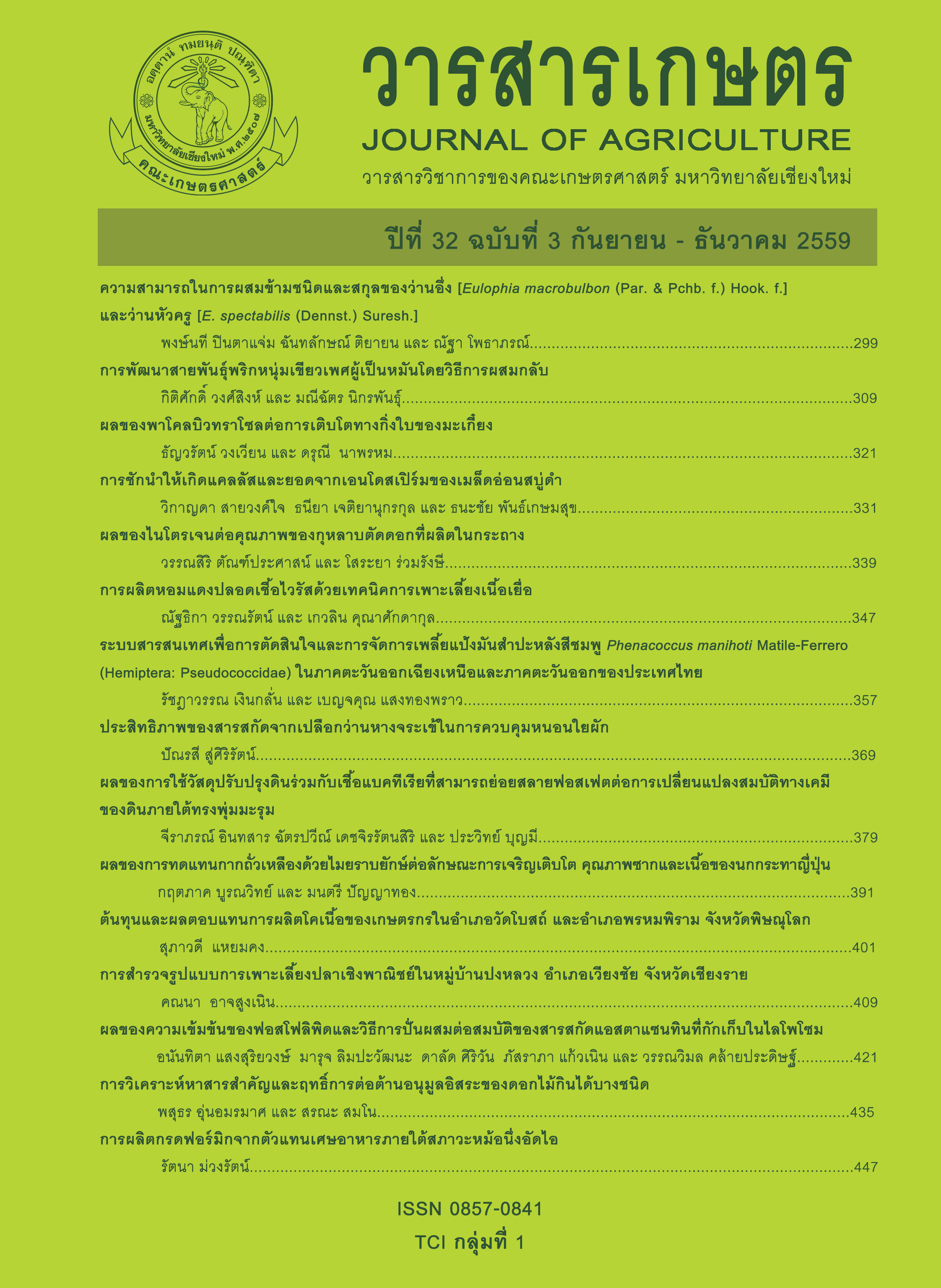Effects of Phospholipid Concentration and Mixing Methods on Properties of Astaxanthin Extract-loaded Liposomes
Main Article Content
Abstract
This study was aimed to improve stability of natural astaxanthin extracted from white shrimp shells (Litopenaeus vannamei) by using liposomal encapsulation technique. Three different concentrations of phospholipids at 0.8, 1.6 and 2.0% w/v together with two different mixing methods including homogenization and sonication were employed. Astaxanthin extract-loaded liposomes were investigated for entrapment efficiency (%EE), antioxidant activity determined by DPPH (2, 2-diphenyl-1-picryl-hydrazyl) radical scavenging capacity and ferrous metal ion chelating activity, morphology of liposomes by using transmission electron microscopy (TEM) and properties changing during 8 weeks storage at 4 ºC. It was found that %EE of liposomes prepared from 2.0% w/v phospholipids and mixed by sonication revealed the least decrease of %EE as compared to that of day 0. Antioxidant activity to eradicate DPPH free radicals and metal ion chelating activity of free astaxanthin was decreased by 76.7% and 56%, respectively which was much lower than that encapsulated in liposomes of all treatments as compared to that of day 0. TEM image of astaxanthin extract-loaded liposomes prepared by sonication demonstrated a lamellar structure. The results suggest the potential use of liposomal encapsulation to protect astaxanthin properties for further application.
Article Details
References
Conn, P.F., W. Schalch and T.G. Truscott. 1991. The singlet oxygen and carotenoid interaction. Journal of Photochemistry and Photobiology B 11, 41-47.
Dinis, T.C.P., V.M.C. Madeira and L.M. Almeida. 1994. Action of phenolic derivatives (Acetaminophen, Salicylate and 5-Aminosalicylate) as inhibitors of membrane lipid peroxidation and peroxyl radical scavengers. Archives of Biochemistry and Biophysics 315(1): 161-169.
Gordon, M.H. 1990. The mechanism of antioxidant action in vitro. In: BJF Hudson (Ed.), Food antioxidants. Elsevier Applied Science, England.
Higuera-Ciapara, I., L. Felix-Valenzuela, F.M. Goycoolea and W. Arguelles-Monal. 2004. Microencapsulation of astaxanthin in a chitosan matrix. Carbohydrate Polymers 56: 41-45.
Kraft, J.C., J.P. Freeling, Z. Wang and R.J.Y. Ho. 2014. Emerging research and clinical development trends of liposome and lipid nanoparticle drug delivery systems. Journal of Pharmaceutical Sciences 103: 29-52
Liu, X. and T. Osawa. 2007. Cis astaxanthin and especially 9-cis astaxanthin exhibits a higher antioxidant activity in vitro compared to the all-trans isomer. Biochemical and Biophysical Research Communications 357:187-193.
Marsanasco, M., A.L. Márquez, J.R. Wagner, S.V. Alonso and N.S. Chiaramoni. 2011. Liposomes as vehicles for vitamins E and C: An alternative to fortify orange juice and offer vitamin C protection after heat treatment. Food Research International 44: 3039-3046.
Meléndez, A., G. Britton, I. Vicario and F. Heredia. 2006. Relationship between the color and the chemical structure of carotenoid pigments. Food Chemistry 101: 1145-1150.
Naguib, Y.M.A. 2000. Antioxidant activities of astaxanthin and related carotenoids. Journal of Agricultural and Food Chemistry 48: 1150-1154.
Peng, C.H., C.H. Chang, R.Y. Peng and C.C. Chyau. 2010. Improved membrane transport of astaxanthine by liposomal encapsulation. European Journal of Pharmaceutics and Biopharmaceutics 75: 154-161.
Pintea, A., H.A. Diehl, C. Momeu, L. Aberle and C. Socaciu. 2005. Incorporation of carotenoid esters into liposomes. Biophysical Chemistry 118: 7-14.
Pu, J., J.D. Bankston and S. Sathivel. 2011. Developing microencapsulated flaxseed oil containing shrimp (Litopenaeus setiferus) astaxanthin using a pilot scale spray dryer. Biosystems Engineering 108: 121-132.
Sachindra, N.M., N. Bhaskar and N.S. Mahendrakar. 2006. Recovery of carotenoids from shrimp waste in organic solvents. Waste Manage. 26: 1092-1098.
Sánchez-Moreno, C., J.A. Larrauri and F. Saura-Calixto. 1999. Free radical scavenging capacity and inhibition of lipid oxidation of wine, grape juices and related polyphenolic constituents. Food Research International 32: 407-412.
Senphan, T., S. Benjakul and H. Kishimura. 2014. Characteristics and antioxidative activity of carotenoprotein from shells of Pacific white shrimp extracted using hepatopancreas proteases. Food Bioscience 5: 54-63.
Shen, Q. and S.Y. Quek. 2014. Microencapsulation of astaxanthin with blends of milk protein and fiber by spray drying. Journal of Food Engineering 123: 165-171.
Sowmya, R. and N.M. Sachindra. 2012. Evaluation of antioxidant activity of carotenoid extract from shrimp processing byproducts by in vitro assays and in membrane model system. Food Chemistry 134: 308-314.
Taksima, T., M. Limpawattana and W. Klaypradit. 2015. Astaxanthin encapsulated in beads using ultrasonic atomizer and application in yogurt as evaluated by consumer sensory profile. LWT - Food Science and Technology 62: 431-437.
Wu, H.C., H.M. Chen and C.Y. Shiau. 2003. Free amino acids and peptides as related to antioxidant properties in protein hydrolysates of mackerel (Scomber austriasicus). Food Research International 36: 949-957.
Yang, S., Q. Zhou, L. Yang, Y. Xue, J. Xu and C. Xue. 2015. Effect of thermal processing on astaxanthin and astaxanthin esters in Pacific white shrimp Litopenaeus vannamei. Journal of Oleo Science 64: 243-253.


